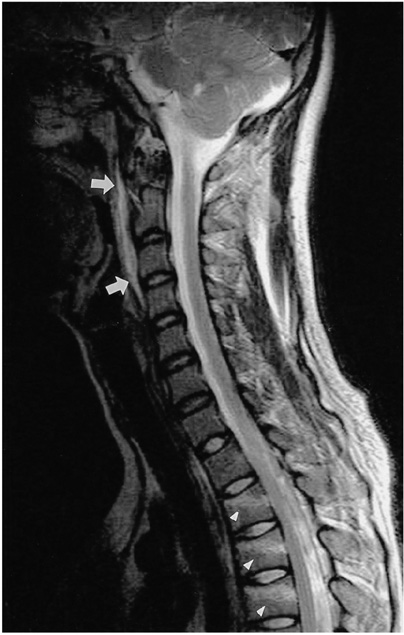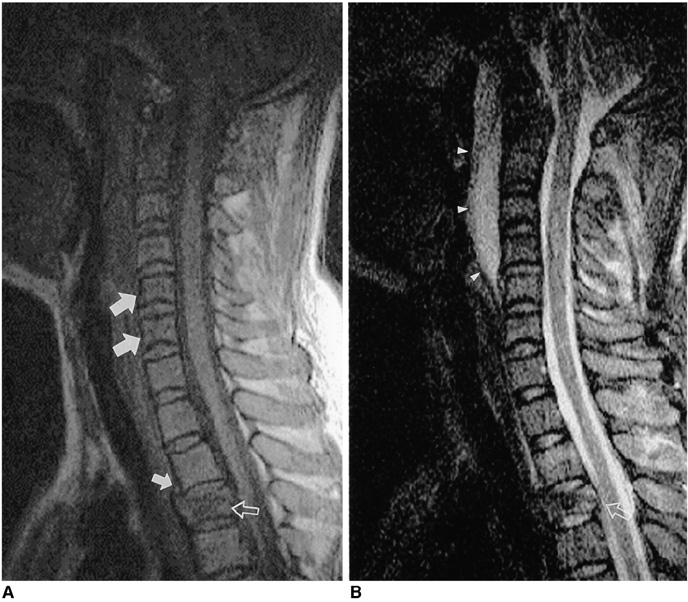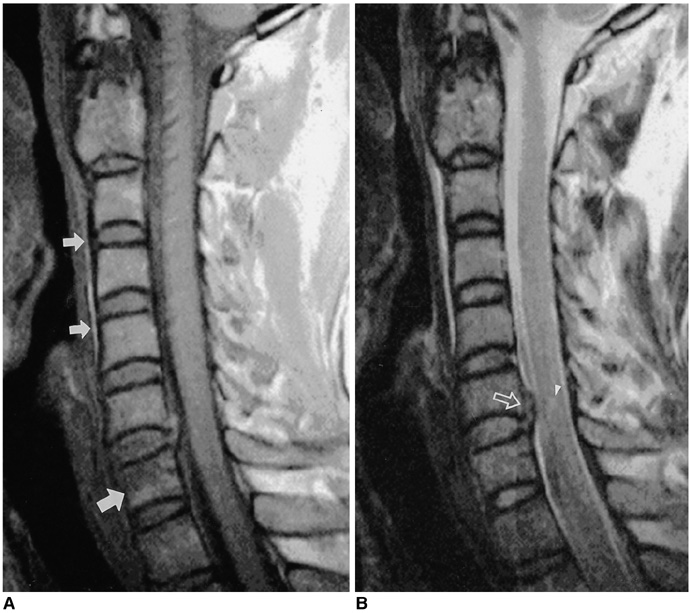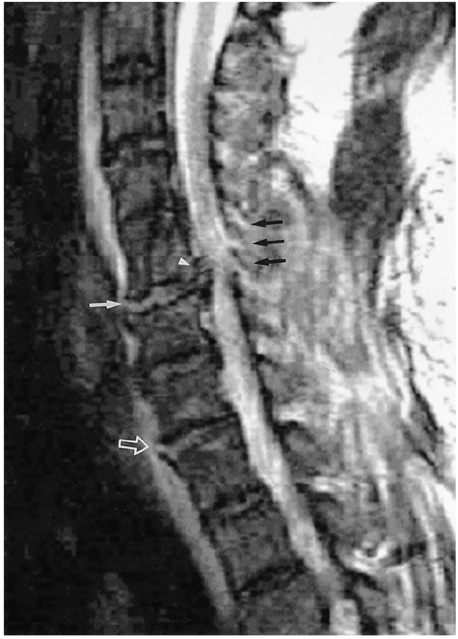Korean J Radiol.
2004 Dec;5(4):219-224. 10.3348/kjr.2004.5.4.219.
Non-Contiguous Spinal Injury in Cervical Spinal Trauma: Evaluation with Cervical Spine MRI
- Affiliations
-
- 1Department of Radiology, Gangneung Asan Hospital, University of Ulsan College of Medicine, Korea. mjshin@www.amc.seoul.kr
- 2Department of Radiology, Asan Medical Center, University of Ulsan College of Medicine, Korea.
- 3Department of Radiology, Sanggyepaik Hospital, Inje University, Korea.
- KMID: 1118828
- DOI: http://doi.org/10.3348/kjr.2004.5.4.219
Abstract
OBJECTIVE
We wished to evaluate the incidence of non-contiguous spinal injury in the cervicothoracic junction (CTJ) or the upper thoracic spines on cervical spinal MR images in the patients with cervical spinal injuries. MATER AND METHODS: Seventy-five cervical spine MR imagings for acute cervical spinal injury were retrospectively reviewed (58 men and 17 women, mean age: 35.3, range: 18-81 years). They were divided into three groups based on the mechanism of injury; axial compression, hyperflexion or hyperextension injury, according to the findings on the MR and CT images. On cervical spine MR images, we evaluated the presence of non-contiguous spinal injury in the CTJ or upper thoracic spine with regard to the presence of marrow contusion or fracture, ligament injury, traumatic disc herniation and spinal cord injury. RESULTS: Twenty-one cases (28%) showed CTJ or upper thoracic spinal injuries (C7-T5) on cervical spinal MR images that were separated from the cervical spinal injuries. Seven of 21 cases revealed overt fractures in the CTJs or upper thoracic spines. Ligament injury in these regions was found in three cases. Traumatic disc herniation and spinal cord injury in these regions were shown in one and two cases, respectively. The incidence of the non-contiguous spinal injuries in CTJ or upper thoracic spines was higher in the axial compression injury group (35.3%) than in the hyperflexion injury group (26.9%) or the hyperextension (25%) injury group. However, there was no statistical significance (p > 0.05). CONCLUSION: Cervical spinal MR revealed non-contiguous CTJ or upper thoracic spinal injuries in 28% of the patients with cervical spinal injury. The mechanism of cervical spinal injury did not significantly affect the incidence of the non-contiguous CTJ or upper thoracic spinal injury.
Keyword
MeSH Terms
-
Acute Disease
Adult
Aged
Aged, 80 and over
Cervical Vertebrae/*injuries
Female
Humans
Incidence
Longitudinal Ligaments/injuries
*Magnetic Resonance Imaging
Male
Middle Aged
Retrospective Studies
Spinal Fractures/diagnosis
Spinal Injuries/classification/*diagnosis/epidemiology
Stellate Ganglion/injuries
Thoracic Vertebrae/*injuries
Tomography, X-Ray Computed
Figure
Reference
-
1. Gupta A, el Masri WS. Multilevel spinal injuries. Incidence, distribution and neurologic patterns. J Bone Joint Surg Br. 1989. 71:692–695.2. Huelke DF, Nusholtz GS. Cervical spine biomechanics: a review of the literature. J Orthop Res. 1986. 4:232–245.3. Lee C, Rogers LF, Woodring JH, Goldstein SJ, Kims KS. Fractures of the craniovertebral junction associated with other fractures of the spine: overlooked entity? AJNR Am J Neuroradiol. 1984. 5:775–781.4. Ryan MD, Henderson JJ. The epidemiology of fractures and fracture-dislocations of the cervical spine. Injury. 1992. 23:38–40.5. Nichols CG, Young DH, Schiller WR. Evaluation of cervicothoracic junction injury. Ann Emerg Med. 1987. 16:640–642.6. Beldekos A, Korres DS, Nikolakakos G. A Chance's fracture in a double level fracture of the spine. Injury. 1981. 13:34–36.7. Blahd WH Jr, Iserson KV, Bjelland JC. Efficacy of the post-traumatic crosstable lateral view of the cervical spine. J Emerg Med. 1985. 2:243–249.8. Harrington T, Barker B. Multiple trauma associated with vertebral injury. Surg Neurol. 1986. 26:149–154.9. Korres DS, Katsaros A, Pantazopoulos T, Hartofilakidis-Garofalidis G. Double or multiple level fractures of the spine. Injury. 1981. 13:147–152.10. Calenoff L, Chessare JW, Rogers LF, Toerge J, Rosen JS. Multiple level spinal injuries: importance of early recognition. AJR Am J Roentgenol. 1978. 130:665–669.11. Vaccaro AR, An HS, Lin S, Sun S, Balderston RA, Cotler JM. Noncontiguous injuries of the spine. J Spinal Disord. 1992. 5:320–329.12. Henderson RL, Reid DC, Saboe LA. Multiple noncontiguous spine fractures. Spine. 1991. 16:128–131.13. Hadden WA, Gillespie WJ. Multiple level injures of the cervical spine. Injury. 1985. 16:628–633.14. Shear P, Hugenholtz H, Richard MT, et al. Multiple noncontiguous fractures of the cervical spine. J Trauma. 1988. 28:655–659.15. Saifuddin A. MR of acute spinal trauma. Skeletal Radiol. 2001. 30:237–246.16. Qaiyum M, Tyrrell PN, McCall IW, Cassar-Pullicino VN. MR detection of unsuspected vertebral injury in acute spinal trauma: incidence and significance. Skeletal Radiol. 2001. 30:299–304.17. Kliewer MA, Gray L, Paver J, et al. Acute spinal ligament disruption: MR imaging with anatomic correlation. J Magn Reson Imaging. 1993. 3:855–861.18. Terk MR, Hume-Neal M, Fraipont M, Ahmadi J, Colletti PM. Injury of the posterior ligament complex in patients with acute spinal trauma: evaluation by MR imaging. AJR Am J Roentgenol. 1997. 168:1481–1486.19. Shimada K, Tokioka T. Sequential MR studies of cervical cord injury: correlation with neurological damage and clinical outcome. Spinal Cord. 1999. 37:410–415.20. Goldberg AL, Rothfus WE, Deeb ZL, et al. The impact of magnetic resonance of the diagnostic evaluation of acute cervicothoracic spinal trauma. Skeletal Radiol. 1988. 17:89–95.21. Allen BL Jr, Ferguson RL, Lehmann TR, O'Brien RP. A mechanistic classification of closed, indirect fractures and dislocations of the lower cervical spine. Spine. 1982. 7:1–27.22. Hoffman JR, Schriger DL, Mower W, Luo JS, Zucker M. Low-risk criteria for cervical-spine radiography in blunt trauma: a prospective study. Ann Emerg Med. 1992. 21:1454–1460.23. Cornelius RS. Imaging of acute cervical spine trauma. Semin Ultrasound CT MR. 2001. 22:108–124.24. Vaccaro AR, Falatyn SP, Flanders AE, Balderson RA, Northrup BE, Cotler JM. Magnetic resonance evaluation of the intervertebral disc, spinal ligament, and spinal cord before and after closed traction reduction of cervical spine dislocations. Spine. 1999. 24:1210–1217.25. Vaccaro AR, Madigan L, Schweitzer ME, Flanders AE, Hilibrand AS, Albert TJ. Magnetic resonance imaging analysis of soft tissue disruption after flexion-distraction injuries of the subaxial cervical spine. Spine. 2001. 26:1866–1872.26. Yousry I, Forderreuther S, Moriggl B, et al. Cervical MR imaging in postural headache: MR signs and pathophysiological implications. AJNR Am J Neuroradiol. 2001. 22:1239–1250.27. Nusholtz GS, Huclke DF, Lux P, Alem NM, Montalvo F. Cervical spine injury mechanisms. 1983. 27 th Sta. In : Car Crash Conference Proceedings; Warredale, PA: Society of Automotive Engineers;179–198.
- Full Text Links
- Actions
-
Cited
- CITED
-
- Close
- Share
- Similar articles
-
- Soft Tissue Damage in Cervical Spine Extension Injury
- Spinal Cord Injury by Ruptured Disc Particles in Cervical Spinal Trauma
- The Secondary Contiguous or Non-contiguous Subchondral Bone Impactions in Subaxial Cervical Spinal Injury: Incidence and Associated Primary Injury Patterns
- Morphological Analysis of the Cervical Spinal Cord, Dural Tube, and Spinal Canal by Magnetic Resonance Imaging in Normal Korean Adults
- Missed Traumatic Cervical Spine Injury





